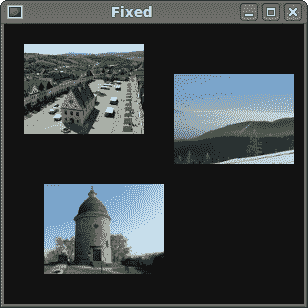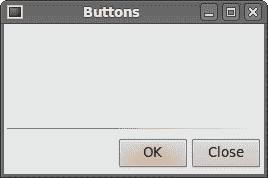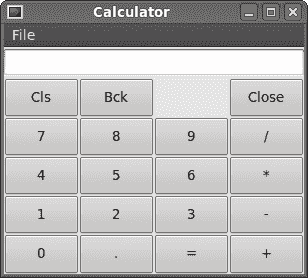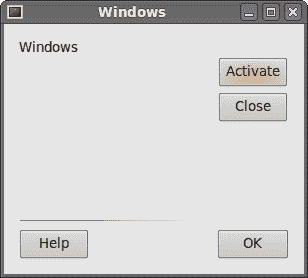在本章中,我们将展示如何在窗口或对话框中布置窗口小部件。
在设计应用的 GUI 时,我们决定要使用哪些小部件以及如何在应用中组织这些小部件。 为了组织窗口小部件,我们使用专门的不可见窗口小部件,称为布局容器。 在本章中,我们将提到GtkAlignment,GtkFixed,GtkVBox和GtkTable。
GtkFixed
GtkFixed容器将子窗口小部件放置在固定位置并具有固定大小。 此容器不执行自动布局管理。 在大多数应用中,我们不使用此容器。 我们在某些专业领域使用它。 例如游戏,使用图表的专用应用,可以移动的可调整大小的组件(如电子表格应用中的图表),小型教育示例。
<?php/*ZetCode PHP GTK tutorialIn this program, we lay out widgetsusing absolute positioning.author: Jan Bodnarwebsite: www.zetcode.comlast modified: September 2011*/class Example extends GtkWindow {public function __construct() {parent::__construct();$this->init_ui();}public function init_ui() {$this->set_title('Fixed');$this->connect_simple('destroy', array('gtk', 'main_quit'));$this->modify_bg(Gtk::STATE_NORMAL, new GdkColor(6400, 6400, 6440));$bardejov = GtkImage::new_from_file("bardejov.jpg");$rotunda = GtkImage::new_from_file("rotunda.jpg");$mincol = GtkImage::new_from_file("mincol.jpg");$fixed = new GtkFixed();$fixed->put($bardejov, 20, 20);$fixed->put($rotunda, 40, 160);$fixed->put($mincol, 170, 50);$this->add($fixed);$this->set_default_size(300, 280);$this->set_position(GTK::WIN_POS_CENTER);$this->show_all();}}new Example();Gtk::main();?>
在我们的示例中,我们在窗口上显示了三个小图像。 我们明确指定放置这些图像的 x,y 坐标。
$this->modify_bg(Gtk::STATE_NORMAL, new GdkColor(6400, 6400, 6440));
为了获得更好的视觉体验,我们将背景色更改为深灰色。
$bardejov = GtkImage::new_from_file("bardejov.jpg");
GtkImage是用于显示图像的小部件。 图片是从磁盘上的文件加载的。
$fixed = new GtkFixed();
我们创建GtkFixed容器。
$fixed->put($bardejov, 20, 20);
我们将第一个图像放置在x = 20,y = 20坐标处。
w.add(fixed);
最后,我们将GtkFixed容器添加到窗口中。

图:固定
按钮
在此代码示例中,我们将使用垂直框,水平框和对齐小部件。 水平框将小部件排列为一行。 同样,垂直框将其小部件放在一列中。 Alignment容器控制其子窗口小部件的对齐方式和大小。
<?php/*ZetCode PHP GTK tutorialIn this program, we position two buttonsin the bottom right corner of the window.We use horizontal and vertical boxes.author: Jan Bodnarwebsite: www.zetcode.comlast modified: August 2011*/class Example extends GtkWindow {public function __construct() {parent::__construct();$this->init_ui();}public function init_ui() {$this->set_title('Buttons');$this->connect_simple('destroy', array('gtk', 'main_quit'));$this->set_border_width(3);$vbox = new GtkVBox(false, 5);$hbox = new GtkHBox(true, 3);$frame = new GtkFrame();$vbox->pack_start($frame, true, true, 0);$okButton = new GtkButton("OK");$okButton->set_size_request(70, 30);$closeButton = new GtkButton("Close");$hbox->add($okButton);$hbox->add($closeButton);$halign = new GtkAlignment(1, 0, 0, 0);$halign->add($hbox);$vbox->pack_start($halign, false, false, 3);$this->add($vbox);$this->set_default_size(260, 150);$this->set_position(GTK::WIN_POS_CENTER);$this->show_all();}}new Example();Gtk::main();?>
在代码示例中,我们在窗口的右下角放置了两个按钮。 为此,我们使用一个水平框,一个垂直框和一个对齐容器。
$vbox = new GtkVBox(false, 5);
将创建一个垂直框容器。 我们将同构成员设置为false。 这意味着放在垂直框中的窗口小部件将具有相同的大小。 小部件之间的垂直间距设置为 5 像素。
$frame = new GtkFrame();
在这里,我们创建一个GtkFrame小部件。 该小部件的目的是占用两个按钮上方的空间。
$vbox->pack_start($frame, true, true, 0);
在这里,我们将框架小部件放入垂直框中。 该方法的第一个参数是小部件,它被放置在框中。 以下三个参数是expand,fill和padding。 expand参数设置为true,这意味着将在小部件周围分配可用空间。 当fill参数设置为true时,小部件实际上会占用其周围的所有可用空间。 子窗口小部件周围没有填充。
$hbox = new GtkHBox(true, 3);
此代码行创建一个水平框。 框内的所有小部件都将具有相同的大小。 小部件之间的水平间隔为 3px。
$okButton = new GtkButton("OK");$okButton->set_size_request(70, 30);$closeButton = new GtkButton("Close");$hbox->add($okButton);$hbox->add($closeButton);
我们创建两个按钮,并将它们放在水平框中。
$halign = new GtkAlignment(1, 0, 0, 0);$halign->add($hbox);$vbox->pack_start($halign, false, false, 3);
这将创建一个对齐容器,它将其子窗口小部件放在右侧。 设置为 1.0 的xalign成员会将所有可用空间放在水平框的左侧。 这将向右推两个按钮。 我们将水平框添加到对齐容器中,然后将对齐容器包装到垂直框中。 我们必须记住,对齐容器仅包含一个子窗口小部件。 这就是为什么我们必须使用水平框。

图:按钮
计算器骨架
GtkTable小部件按行和列排列小部件。
<?php/*ZetCode PHP GTK tutorialIn this program we create a skeleton ofa calculator. We use the GtkTable widget.author: Jan Bodnarwebsite: www.zetcode.comlast modified: August 2011*/class Example extends GtkWindow {public function __construct() {parent::__construct();$this->init_ui();}public function init_ui() {$this->set_title('Calculator');$this->connect_simple('destroy', array('gtk', 'main_quit'));$vbox = new GtkVBox(false, 2);$mb = new GtkMenubar();$filemenu = new GtkMenu();$filemi = new GtkMenuItem("File");$filemi->set_submenu($filemenu);$mb->append($filemi);$vbox->pack_start($mb, false, false, 0);$table = new GtkTable(5, 4, true);$table->attach_defaults(new GtkButton("Cls"), 0, 1, 0, 1);$table->attach_defaults(new GtkButton("Bck"), 1, 2, 0, 1);$table->attach_defaults(new GtkLabel(), 2, 3, 0, 1);$table->attach_defaults(new GtkButton("Close"), 3, 4, 0, 1);$table->attach_defaults(new GtkButton("7"), 0, 1, 1, 2);$table->attach_defaults(new GtkButton("8"), 1, 2, 1, 2);$table->attach_defaults(new GtkButton("9"), 2, 3, 1, 2);$table->attach_defaults(new GtkButton("/"), 3, 4, 1, 2);$table->attach_defaults(new GtkButton("4"), 0, 1, 2, 3);$table->attach_defaults(new GtkButton("5"), 1, 2, 2, 3);$table->attach_defaults(new GtkButton("6"), 2, 3, 2, 3);$table->attach_defaults(new GtkButton("*"), 3, 4, 2, 3);$table->attach_defaults(new GtkButton("1"), 0, 1, 3, 4);$table->attach_defaults(new GtkButton("2"), 1, 2, 3, 4);$table->attach_defaults(new GtkButton("3"), 2, 3, 3, 4);$table->attach_defaults(new GtkButton("-"), 3, 4, 3, 4);$table->attach_defaults(new GtkButton("0"), 0, 1, 4, 5);$table->attach_defaults(new GtkButton("."), 1, 2, 4, 5);$table->attach_defaults(new GtkButton("="), 2, 3, 4, 5);$table->attach_defaults(new GtkButton("+"), 3, 4, 4, 5);$vbox->pack_start(new GtkEntry(), false, false, 0);$vbox->pack_end($table, true, true, 0);$this->add($vbox);$this->set_default_size(300, 250);$this->set_position(GTK::WIN_POS_CENTER);$this->show_all();}}new Example();Gtk::main();?>
我们使用GtkTable小部件创建一个计算器框架。
$table = new GtkTable(5, 4, true);
我们创建一个具有 5 行 4 列的表小部件。 第三个参数是同质参数。 如果设置为true,则表中的所有小部件都具有相同的大小。 所有窗口小部件的大小等于表容器中最大的窗口小部件。
$table->attach_defaults(new GtkButton("Cls"), 0, 1, 0, 1);
我们在表格容器上附加一个按钮。 到表格的左上方单元格。 前两个参数是单元格的左侧和右侧,后两个参数是单元格的顶部和左侧。
$vbox->pack_end($table, true, true, 0);
我们将表格小部件打包到垂直框中。

图:计算机骨架
窗口
接下来,我们将创建一个更高级的示例。 我们显示一个窗口,可以在 JDeveloper IDE 中找到它。
<?php/*ZetCode PHP GTK tutorialThis is a more complicated layout example.We use GtkAlignment and GtkTable widgets.author: Jan Bodnarwebsite: www.zetcode.comlast modified: August 2011*/class Example extends GtkWindow {public function __construct() {parent::__construct();$this->init_ui();}public function init_ui() {$this->set_title('Windows');$this->connect_simple('destroy', array('gtk', 'main_quit'));$this->set_border_width(15);$table = new GtkTable(8, 4, false);$table->set_col_spacings(3);$title = new GtkLabel("Windows");$halign = new GtkAlignment(0, 0, 0, 0);$halign->add($title);$table->attach($halign, 0, 1, 0, 1, GTK::FILL,GTK::FILL, 0, 0);$frame = new GtkFrame();$table->attach($frame, 0, 2, 1, 3, GTK::FILL | Gtk::EXPAND,GTK::FILL | GTK::EXPAND, 1, 1);$activate = new GtkButton("Activate");$activate->set_size_request(50, 30);$table->attach($activate, 3, 4, 1, 2, GTK::FILL,GTK::SHRINK, 1, 1);$valign = new GtkAlignment(0, 0, 0, 0);$close = new GtkButton("Close");$close->set_size_request(70, 30);$valign->add($close);$table->set_row_spacing(1, 3);$table->attach($valign, 3, 4, 2, 3, Gtk::FILL,Gtk::FILL | Gtk::EXPAND, 1, 1);$halign2 = new GtkAlignment(0, 1, 0, 0);$help = new GtkButton("Help");$help->set_size_request(70, 30);$halign2->add($help);$table->set_row_spacing(3, 6);$table->attach($halign2, 0, 1, 4, 5, Gtk::FILL,Gtk::FILL, 0, 0);$ok = new GtkButton("OK");$ok->set_size_request(70, 30);$table->attach($ok, 3, 4, 4, 5, Gtk::FILL,Gtk::FILL, 0, 0);$this->add($table);$this->set_default_size(300, 250);$this->set_position(GTK::WIN_POS_CENTER);$this->show_all();}}new Example();Gtk::main();?>
该代码示例显示了如何在 PHP GTK 中创建类似的窗口。
$table = new GtkTable(8, 4, false);$table->set_col_spacings(3);
该示例基于GtkTable容器。 列之间将有 3px 的间隔。
$title = new GtkLabel("Windows");$halign = new GtkAlignment(0, 0, 0, 0);$halign->add($title);$table->attach($halign, 0, 1, 0, 1, GTK::FILL,GTK::FILL, 0, 0);
这段代码创建了一个向左对齐的标签。 标签放置在Table容器的第一列的第一行中。
$frame = new GtkFrame();$table->attach($frame, 0, 2, 1, 3, GTK::FILL | Gtk::EXPAND,GTK::FILL | GTK::EXPAND, 1, 1);
框架小部件跨越两行两列。 它将消耗其周围的所有可用空间。 因此,占用了窗口的大部分区域。
$valign = new GtkAlignment(0, 0, 0, 0);$close = new GtkButton("Close");$close->set_size_request(70, 30);$valign->add($close);$table->set_row_spacing(1, 3);$table->attach($valign, 3, 4, 2, 3, Gtk::FILL,Gtk::FILL | Gtk::EXPAND, 1, 1);
我们将关闭按钮放在框架小部件旁边,进入第四列。 (我们从零开始计数)将按钮添加到对齐小部件中,以便可以将其对齐到顶部。
$halign2 = new GtkAlignment(0, 1, 0, 0);$help = new GtkButton("Help");$help->set_size_request(70, 30);$halign2->add($help);$table->set_row_spacing(3, 6);$table->attach($halign2, 0, 1, 4, 5, Gtk::FILL,Gtk::FILL, 0, 0);
将帮助按钮放置在对齐小部件中,以便可以在其表格单元格中使其对齐。 它位于第一列第五行。
$ok = new GtkButton("OK");$ok->set_size_request(70, 30);$table->attach($ok, 3, 4, 4, 5, Gtk::FILL,Gtk::FILL, 0, 0);
最后,单击确定按钮。 它位于第四列和第五行。

图:窗口
在 PHP GTK 教程的这一部分中,我们提到了小部件的布局管理。

